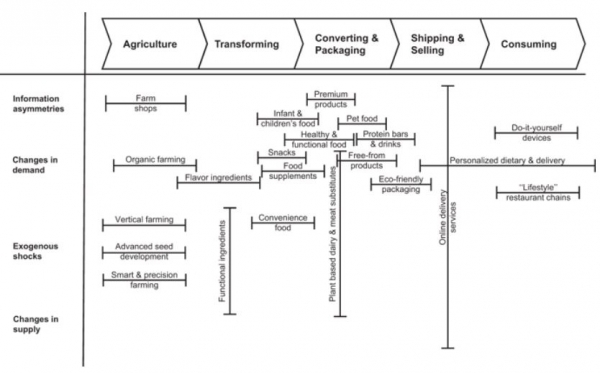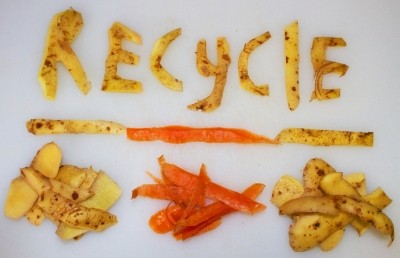‘Dramatic potential’ for innovation that re-thinks the food chain

A new study, published in Nature Partner Journals (NPJ) Science of Food, has mapped entrepreneurial opportunities in the food sector, by applying “classic economic sources of entrepreneurial opportunities” across the five steps of the food value chain to identify areas of innovation.
Researchers from the University of Hohenheim, headed up by Dr. Andreas Kuckertz, noted that there are classically four sources of entrepreneurial opportunity. These include consumer-led change in demand, such as evolving expectations around healthy or sustainable food; changes in supply, including the development of new ingredients; “information asymmetries” that can see the development of new ways of using data, like the development of digital platforms; and what the researchers called “exogenous shocks” that alter existing markets, such as regulatory developments.
Follow the money
The research team then analysed investment behaviour in Europe and the US to determine where investors perceive the most significant areas of opportunity.
The study defined the food value chain as consisting of five steps: agriculture – crop and livestock cultivation; “transforming” – processing raw materials into ingredients; “converting and packaging” - processing ingredients into finished products and packaging these; “shipping and selling” – transportation and retail; and consumption – the preparation of meals in or out of the home.
Looking at the Dow Jones VentureSource, which covers investments in food start-ups, for the years 2013 to 2017, they found the database included 942 investments in Europe and 1821 in the US.
They found overall investment activity in the food value chain rose from 443 deals in 2013 to 747 in 2017, indicating an “intensified” interest in food start-ups.
Using their five-step model of the food chain, they found 62.69% of deals targeted the third step of the food value chain, food processing and packaging. The other four steps of the food value chain attract “considerably less investment”, with shipping and selling accounting for 13.97% of the deals and agriculture attracting 13.46%. “Transforming” (turning crops and livestock into food ingredients) and “consuming” appear to “offer less interesting entrepreneurial opportunities”, attracting only 5.68% and 4.20% of investments in food start-ups respectively, the researchers concluded.
Mapping the opportunity
By rigorously coding the start-ups in the sample to assign them to one of the nominated steps of the value chain it was possible to reconstruct the entrepreneurial opportunity space in the food sector. This was achieved by plotting the four sources of entrepreneurial opportunity against the five-step conceptualisation of the food value chain.
“The resulting matrix of the opportunity space displays entrepreneurial opportunities within the food sector categorised by the conceptualised value chain of the food industry on the horizontal axis and by the four drivers of opportunities on the vertical axis. Each bar within the matrix represents an entrepreneurial opportunity within the food sector.”
Opportunities within converting & packaging are mainly driven by change in demand, whereas the main sources of opportunities within agriculture seem to be related to exogenous shocks to the market such as global population growth or climate change that call for more efficiency in agricultural production.
“The converting & packaging step offers a plethora of opportunities owing to a change in demand. This step of the food value chain holds potential for entrepreneurs seeking to differentiate themselves from their competitors. The rising awareness of health issues when combined with the growing proportion of the population reporting food allergies facilitates a complete sector branch dedicated to so-called free from products, but also for food supplements, fitness protein drinks, or power bars,” the researchers concluded.
Opportunities are not always facilitated by only one source, they continued, pointing to the rise of meat and dairy alternatives. “Currently, there is widespread recognition of the need for input reduced production to reflect the issues of climate change and population growth (exogenous shocks), an increasing awareness of environmental pollution and animal welfare (change in demand), and of new technological abilities in biotechnology and process engineering (change in supply), the combination of which fosters opportunities in this emerging sector branch.”
Online delivery models are another example of divergent drivers coming together to deliver innovative new models, they suggested.
Future innovation opportunities
However, while these areas are currently attracting the highest investment levels, there is still room to innovate in parts of the food chain that receive less attention, such as packaging and shipping, Dr. Kuckertz suggested.
“Following the money is an easy way to predict that people perceive opportunity in a particular area, but it goes along with the classic threat of 100 start-ups each aiming for 20% market share in a particular area with a similar business model. Obviously, in a situation like this, many are likely to fail, so it is definitely interesting to stand out from the crowd by targeting areas that receive less attention. The prerequisite for doing so would however be to identify a pressing problem in this area that one can cater to,” he told FoodNavigator.
In particular, plastics could prove fertile ground for innovation because of the regulatory changes coming in like Europe’s directive on single use plastics. “At least in the EU the regulatory change is most certainly a major game changer. Most businesses relying on plastics have not yet realised that this will affect the way they conduct their business. Whether such a change will spill over to the US or Asia will be interesting to see.”
He also believes that innovation tackling ‘big picture’ challenges and focusing less on the consumer demand side could have significant disruptive potential in the future. “Over the years I have learned to become very humble with such evaluations. But, the change triggered by simply developing one food product that caters to the sustainability demands of consumers, is obviously limited. Unfortunately, many innovators in the food sector seem to think exactly in such a way.
“There is obviously a more dramatic potential in rethinking the complete value chain with a valid goal (e.g. reducing food waste) and, for instance, employing cutting edge digital technology to achieve this.”
Source
'Entrepreneurship and entrepreneurial opportunities in the food value chain'
npj Science of Food
Published online 2019/04/16
DOI: https://doi.org/10.1038/s41538-019-0039-7
Authors: A Kuckertz, S Hinderer, P Röhm


















